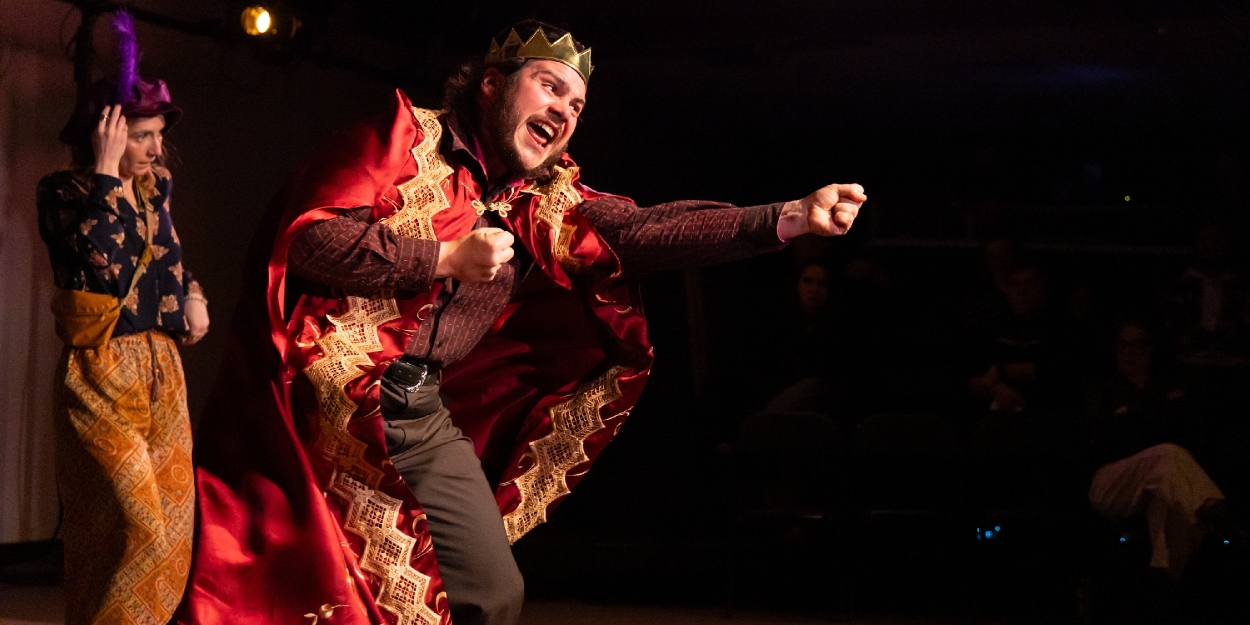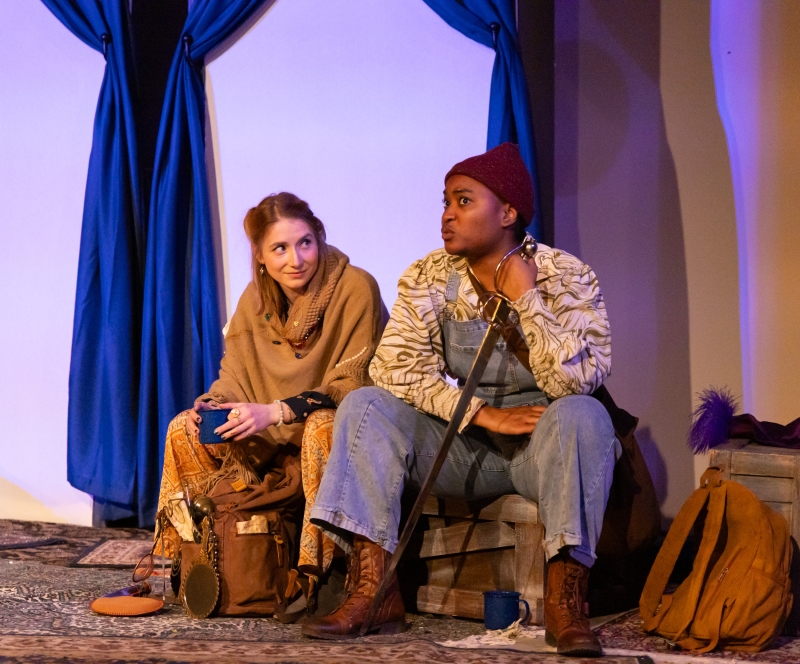Review: THE FIGS at Rorschach Theatre
Now on stage through March 16th, 2025.

Theater-goers searching for something off the beaten path may find their curiosity satiated at Rorschach Theatre’s production of The Figs, on stage now through March 16.
Written by Doug Robinson and directed by Randy Baker, The Figs plays with classic fairytale archetypes and embedded narratives in an “immersive” (and disorienting) two-level performance space on Connecticut Avenue. The play’s primary action launches from a mad King’s (Robert Pike) obsession with figs, his supply of which is rapidly dwindling. This compels him to proclaim that any fig farmer whose lands he hasn’t already razed of the precious fruit may bring him a sample and win the opportunity for his daughter’s hand in marriage. Incensed by her father’s decree, Princess Sadie (Lisette Gabrielle) runs off to be with her lover, an innkeeper named Lorna (Katrina Clark). Meanwhile, a fig farmer named June (Arika Thames) embarks on a long journey to the king’s castle. A Storyteller (Mollie Greenberg) narrates throughout, butting in and out of the action, providing exposition, playing various side characters, and switching scenes with a snap of her fingers as she tries to wrangle an increasingly unruly story. This sounds like a promising premise, particularly when one reads Rorschach’s synopsis claiming that the play “deconstructs traditional storytelling,” but the unfortunate reality of The Figs is of a chaotic, disjointed, and ultimately unfinished tale.
There is some deconstruction that The Figs pulls off, particularly in its embedded queerness and color-blind casting—elements that, while becoming more common in modern stories are certainly still far from the norm, and which are completely unchallenged in the world of the play. It is completely normal for Princess Sadie to have a woman lover (or to have any lovers at all), for example.
The character of Princess Sadie is the clearest indication that The Figs is trying to be intentional about deconstruction. Her role as Princess is clearly defined and her bold, inquisitive, and sexually liberated nature directly contradicts traditional stereotypes of purity and innocence. One could argue that the King, too, is a recognizable archetype that is then flipped: a powerful leader who commands the fear of his subjects, yet whose lack of impulse control and comical obsession with figs renders him entirely unrespectable to the point of ludicrousness. However, any intentional deconstruction seems to end here. It is strange that The Figs does not take advantage of other major opportunities for deconstruction, namely with June, the play’s humble farmer protagonist, who still follows all of the major beats of a traditional hero’s journey.

There are many other instances where the play feels incompletely realized. Take the immersive element to Rorschach’s production, for example. The show begins and shortly thereafter the audience is led from the main lobby to the venue’s basement level. Downstairs, they find a circle of chairs surrounding a fig tree and are introduced to June and his family of fig farmers. After hearing of the king’s decree, June’s oldest brother sets off to the castle with a bag of figs, and the audience is ushered to follow him into a new space, a larger set where the rest of the play takes place. However, June soon appears on this new stage despite the implication he is still located at the fig farm, where the audience has just departed. The result is a bumpy, disjointed start to the first fifteen minutes of the show.
Similarly, despite various tangents into the histories and preoccupations of the play’s many side characters, they often feel underdeveloped, more often the butt of a joke than anything more. Others seem ill-fitting within the play’s fairytale setting. Late in the show, for example, audiences are introduced to the Devil, Death, and an Angel. However, nothing in the preceding action has indicated such Christian religious concepts are a part of the play’s world. You see why the Storyteller must try so hard to keep the story in line: The Figs is biting off more than it can chew, much like its rapacious King.
It is frustrating to watch this and also see real opportunities here for a good play, if only they were more carefully fleshed out. In my eyes, the most unfortunate lost opportunity is with a story the innkeeper character Lorna tells at roughly the play’s mid-point: that of the Child and the Moon. This, I believe, is exactly what the play is trying to do. Here is a fable within a fairytale, beautifully rendered with the aid of a silkscreen and projection, told not by a protagonist, or a storyteller, or a wise mentor, but by a simple innkeeper at a roadside tavern to a bar of thirsty patrons. The ordinary character is made extraordinary, becoming more than just an archetype, by both this moment of storytelling. For this brief and delightful moment, the play works, only to descend back into muddy disorder soon after.
The Figs tries to play with the perceived constraints of what stories can and cannot do—what they are and are not allowed to do. It’s an exciting idea. Yet, ultimately, the play relies on the fairytale as a familiar organizing principle but doesn't take full advantage of the opportunities that playing with such a long-established form provides. My impression after opening night was that I had just watched a rough draft of what could be a unique, funny, whimsical show. Unfortunately, it’s just not there yet.
While the story didn’t work for me, it could certainly work for others, particularly those in search of a chaotic, irreverent comedy that plays with myth and magic. The Figs is onstage at Rorschach Theatre through March 16, 2025. Run time is approximately two hours with one intermission.
Photo Credit: Ryan Maxwell Photography
Cover photo features Mollie Greenberg & Robert Pike.
Reader Reviews
Videos

